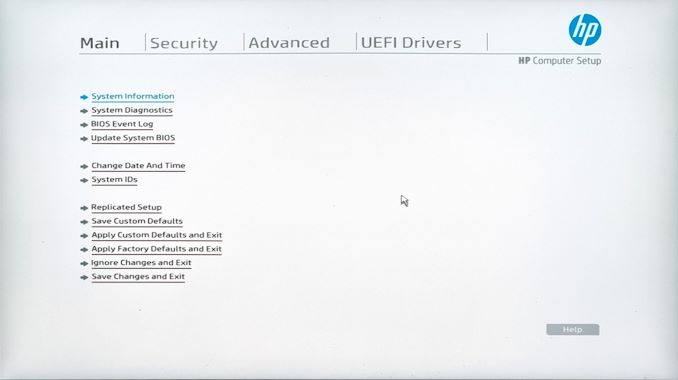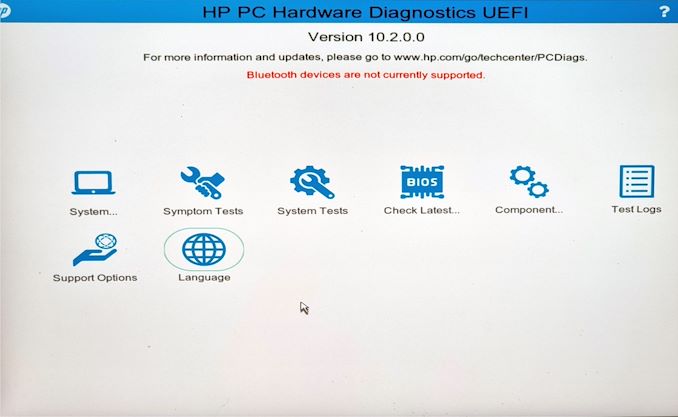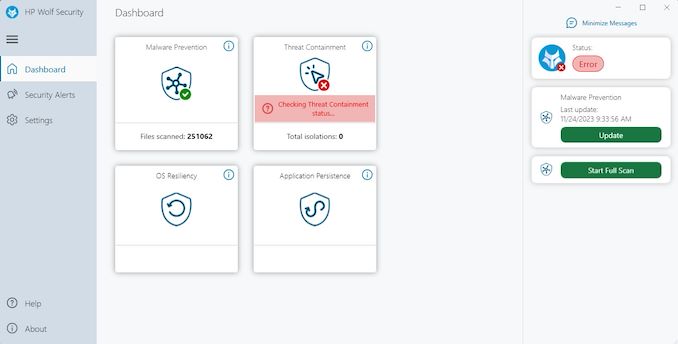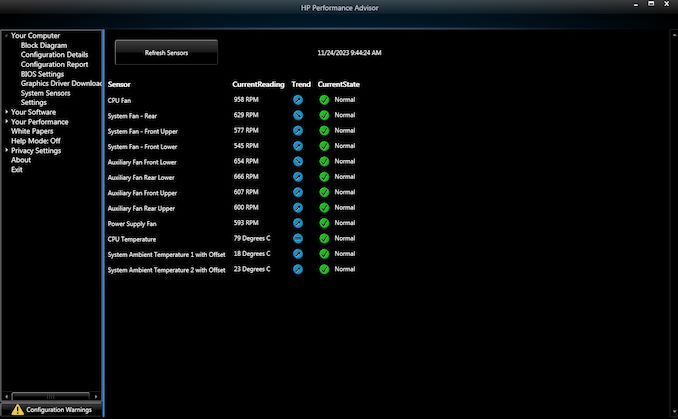HP Z6 G5 A Workstation Review: 96-Core AMD Ryzen Threadripper Pro 7995WX Impresses
by Gavin Bonshor on December 13, 2023 9:40 AM ESTBIOS And Software
As with pre-built workstations from larger OEMs such as HP, Lenovo, or Dell, they come with custom firmware similar to conventional desktop systems but with much less fanfare. In the case of the HP Z6 G5 A, everything regarding the functionality and layout is fully geared towards providing everything a user needs to customize variables. This includes things such as security, I/O, and a robust hardware diagnostics suite directly within the firmware. The HP firmware has a predominately white background, with black text and sky blue highlighting to signify which menu or option is selected at the time.
Note: Given that the HP Z6 G5 A firmware doesn't have a screenshot key, nor do I have a capture card (I know), we apologize for the images we've had to take off the monitor.
On the initial splash screen within the HP Z6 G5 A firmware, the main menus stretch along the top of the screen, while the options and sub-menus are located on the left-hand side. Much of the main functionality can be accessed from the main menu, with the systems diagnostics sub-menu standing out as the most functional of the options.
Users can run many tests within the hardware diagnostics menu, including specific tests for CPU, memory, and storage, and diagnose particular issues, such as Bluescreen crashes and boot-related problems with the symptoms test toolset. Each specific test represents a different level of intensity; for example, the memory test option has a fast and quick test, with a more extensive test that will take much longer to run but is more likely to scrutinize the hardware itself to find any issues.
Overall, the firmware is specifically geared toward the components and design characteristics of the HP Z6 G5 A and critical functionalities. It has everything needed for workstation users to set up networks: remote access functionality, a system information panel, a function for checking if the firmware installed is the latest available, and all of HP's included diagnostic tools to sweeten the deal.
Moving onto the software side of things, HP includes their Wolf Security suite with the Z6 G5 A, which provides endpoint-level software security protection. One of the main features is 'Threat Containment' which is designed to protect against CPU-enforced malware, such as phishing and ransomware attacks. This also includes hardware-enforced virtual machines, with things like OS Resiliency offering OS-level protection for files and applications. Users can read more about HP's Wolf Security suite here.
The other software application supplemented with the Z6 G5 A is HP Performance Advisor, which offers a Windows-based interface that enhances the workstation experience by focusing on three main aspects: system configuration, software tuning, and performance monitoring. This is particularly valuable given the Z6 G5 A’s extensive customization and supported hardware configurations. Users can easily and effortlessly configure their systems within Windows, ensuring that all components, including the CPU and GPUs, are optimized for their specific workload.
Other benefits of the HP Performance Advisor include its ability to provide real-time reports on hardware and application configurations. Additionally, the tool’s automatic updates ensure that users are always working with the latest drivers and optimizations, which is vital in critical applications such as machine learning. Overall, the HP Performance Advisor adds plenty of consolidated software support to a very powerful workstation, and the added benefits of being able to optimize for a variety of software applications, including those from Adobe, ANSYS, and Siemens Digital, are certainly welcomed.


























23 Comments
View All Comments
SanX - Thursday, December 28, 2023 - link
What simulation specifically?SanX - Thursday, December 28, 2023 - link
Pretty funny is that on EBAY there is little interest in numerous AMD 96-core EPYC 9654 which now go for less than $2k, all are paying twice or more for 48-core 9474F. Poor singe core performance at their low clocks is probably the reason. The cheap consumer 7995X beats them all here and is only 2-2.5 times slower at multithread at 5% the price according to cpubenchmark dot net websiteSanX - Thursday, December 28, 2023 - link
7950x not 7995x